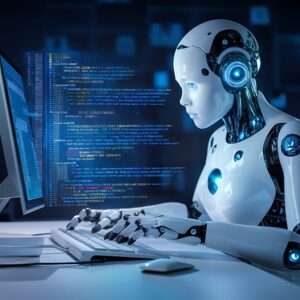The Future of AI Automation: What No One Is Talking About (Yet)!
Glimmering on the horizon, The Future of AI Automation promises a whirlwind of transformation unlike anything humanity has witnessed before. Picture a world where mundane tasks vanish overnight, where artificial intelligence doesn’t just assist but autonomously reshapes entire industries. This isn’t a distant dream—it’s unfolding within the next 36 months, starting in 2025. Experts in technology and finance are buzzing with anticipation, some even trembling at the sheer speed of this shift. Imagine a landscape where efficiency skyrockets, costs plummet, and safety improves, all at once. Historically, progress has rarely been this seamless, yet here it stands, defying the odds. The coming years—2025, 2026, and 2027—hold the keys to a frontier that’s better, faster, safer, and cheaper. Buckle up as this article unveils what insiders see behind closed doors, a revolution poised to redefine civilization itself.
We strongly recommend that you check out our guide on how to take advantage of AI in today’s passive income economy.
Table of Contents
The Automation Cliff: 2025’s Big Shift
By the end of 2025, The Future of AI Automation will hit what experts dub the “automation cliff.” Visualize a typical office buzzing with activity one day—spreadsheets, emails, and meetings—and the next, AI agents silently take over, executing tasks with precision. These aren’t simple chatbots chirping responses; they’re autonomous systems, varying in independence like a spectrum of digital lifeforms. Some require human nods for every step, while others orchestrate entire workflows solo. Tech and finance leaders whisper that this leap outpaces even the cloud computing boom, arriving 40 to 50 years ahead of schedule. Swarms of specialized AI agents will emerge, collaborating or even competing to tackle complex challenges. Imagine a digital ecosystem where each agent flexes its own autonomy level, creating a harmonious yet dynamic workforce. This isn’t gradual—it’s a cliff, a sudden drop into a new reality.
Three Breakthroughs Driving the Change
The Future of AI Automation rests on three jaw-dropping breakthroughs already in motion. First, scaling laws have cracked open AI’s potential—scientists can now mathematically predict the compute, data, and power needed for smarter systems. Artificial Super Intelligence (ASI) isn’t a wild guess anymore; it’s a formula waiting to be filled. Second, letting AI “think” longer—known as inference time compute scaling—boosts its abilities by orders of magnitude. Picture an AI pausing, pondering, and then delivering genius-level solutions. Third, distillation flips the script: one AI teaches another, and the student surpasses the master exponentially. It’s evolution on steroids, happening in real-time. When Open AI co-founder Ilya Sutskever spotted this pattern, he bolted to launch a superintelligence-focused venture, signaling a seismic shift. These pillars aren’t theoretical—they’re here, fueling 2025’s transformation.
Autonomous Agents Take Over in 2025
Zoom into 2025, and The Future of AI Automation unveils autonomous agents as the stars of the show. Imagine a swarm of digital workers, each assigned a role—researching, writing, managing logistics—operating with eerie independence. Experts liken this to self-driving car autonomy levels, but for AI tasks. Some agents need human oversight, checking in like cautious interns; others run whole processes, confident and unshackled. Picture a Fortune 500 company rolling out hybrid teams—human managers guiding both flesh-and-blood staff and AI operators. Every computer-based task, from data entry to strategy, faces automation, with oversight varying by complexity and risk. Agentic flows—networks of bots and swarms—will connect, turning chaos into streamlined brilliance. This year marks the tipping point where AI stops assisting and starts leading.
A Peek Into Agentic Workflows
The Future of AI Automation thrives on agentic workflows, a ballet of AI coordination. Envision an AI named Nova—it picks its own name, by the way—kicking off a task. Nova delegates to a research agent, which scours the web, pulling data with surgical precision. That research fuels a content agent, crafting polished articles or reports in minutes. Need enhancements? Another agent embeds relevant resources, like links or files, then saves it to a cloud drive and pings an email alert. It’s a seamless relay race, with approval steps baked in for human control. These workflows don’t just save time—they redefine productivity, automating intakes, customer greetings, even sales pipelines. By late 2025, companies will lean on these systems, marrying human ingenuity with AI efficiency.
Logistics Revolution by Late 2025
The Future of AI Automation doesn’t stop at desks—it’s reshaping logistics too. Picture a groundbreaking partnership between a tech firm and a logistics giant, announced with fanfare in 2025. Together, they harness AI to overhaul landside logistics—think trucks, warehouses, and supply chains humming with newfound efficiency. Cutting-edge agents optimize routes, predict delays, and manage inventory, slashing costs and delays. Visualize a warehouse where AI directs robotic arms and drones, goods flowing like a perfectly choreographed dance. This collaboration signals a broader trend: industries adopting AI not as a tool but as a core driver. By year-end, expect supply chains transformed, a testament to automation’s relentless march.
2026: Robots Enter the Physical World
Fast forward to 2026, and The Future of AI Automation leaps into the physical realm with embodied autonomy. Imagine humanoid robots stepping off assembly lines—Figure’s bots already ship to early adopters, with Boston Dynamics hot on their heels. Nvidia, a titan in tech, predicts cracking the Robot World Model by mid-2026, letting robots navigate reality like humans. Picture a sleek, metallic figure stacking boxes or assembling parts, its sensors mapping the world in real-time. First-generation models might cost $80,000, but basic utility bots dip to $2,000-$10,000—think used-car prices. These pioneers won’t be perfect, much like the clunky first iPhone, but they’ll spark a revolution. Digital intelligence merges with physical action, reshaping factories, homes, and beyond.
2027: The Dawn of Super Intelligence
By 2027, The Future of AI Automation crowns itself with Artificial Super Intelligence (ASI). Visualize AI systems that don’t just learn but evolve, improving themselves without human hands. Those three breakthroughs—scaling laws, inference scaling, and distillation—form a feedback loop, accelerating progress beyond comprehension. Imagine an AI inventing tools or strategies humans can’t fathom, its capabilities doubling monthly. Every major lab—Google, Open AI, and more—sees this horizon, with no single player holding the reins. Elon Musk pegs superintelligence’s dawn at April 2025, while Google’s AI chief and Sam Altman echo its inevitability. This isn’t smarter AI—it’s a new species of intellect, unleashed and unstoppable.
Why This Speed Is Unprecedented
The Future of AI Automation moves at a pace that stuns even experts. Unlike past revolutions—steam engines or electricity—that unfolded over decades, this one compresses into months. Picture a graph spiking upward, each leap dwarfing the last, as AI models outstrip today’s best overnight. Today’s systems are the weakest they’ll ever be; tomorrow’s will dazzle. No company owns this future—labs worldwide race toward the same ASI finish line. Imagine a global chessboard where every player masters the game simultaneously, rewriting the rules. This velocity, paired with accessibility, ensures automation permeates every corner of life. It’s not a trend—it’s a tidal wave, crashing now.
The First Movers’ Advantage
In The Future of AI Automation, victory belongs to the bold—the first movers. Picture companies pivoting now, weaving AI into their DNA, outpacing rivals stuck in old ways. Visualize a CEO greenlighting hybrid teams in 2025, robots in 2026, and ASI-driven innovation by 2027. These pioneers won’t just survive—they’ll shape the future, building empires of efficiency and abundance. Contrast that with firms clinging to manual processes, fading into irrelevance. This shift rivals the Industrial Revolution, but its stakes are higher and its timeline tighter. Imagine standing at this crossroads, deciding today whether to lead or lag. The brave will thrive; the hesitant will vanish.
Conclusion: Embrace the Age of Abundance
The Future of AI Automation isn’t a distant sci-fi tale—it’s here, reshaping 2025, 2026, and 2027 before our eyes. Picture a world where office work evaporates, robots roam factories, and superintelligence redefines possibility—all in three years. This isn’t about fear; it’s about opportunity, a chance to harness AI’s power for a better tomorrow. Imagine a society where repetitive tasks fade, freeing humans for creativity and connection. The next 36 months will redraw civilization’s map, and those ready to adapt will steer its course. Dive into this age of agentic flows, embodied autonomy, and ASI-driven abundance. The revolution beckons—will you answer its call?

We strongly recommend that you check out our guide on how to take advantage of AI in today’s passive income economy.




